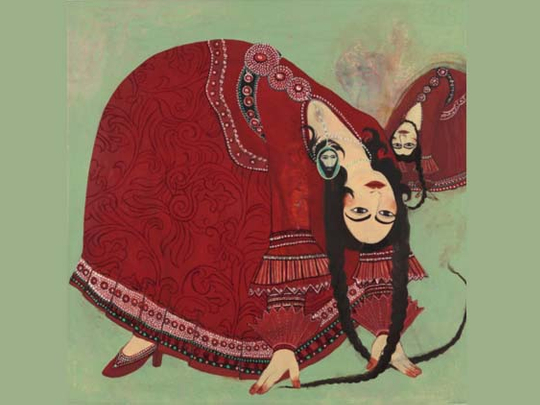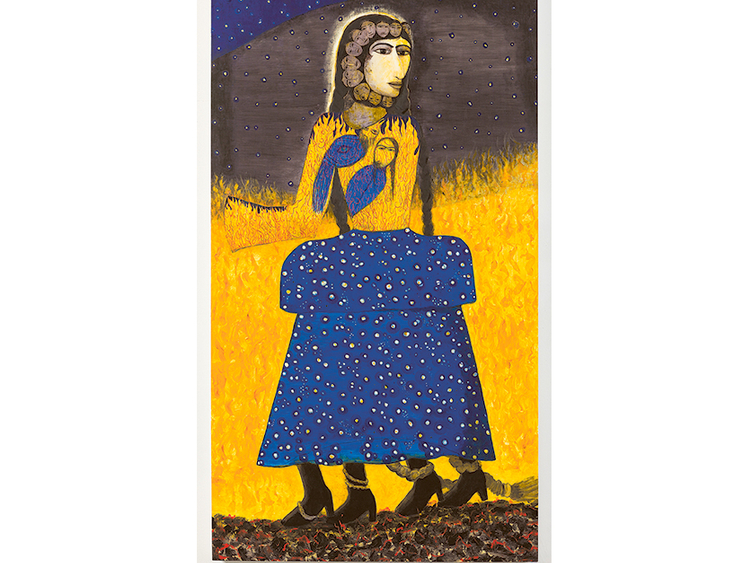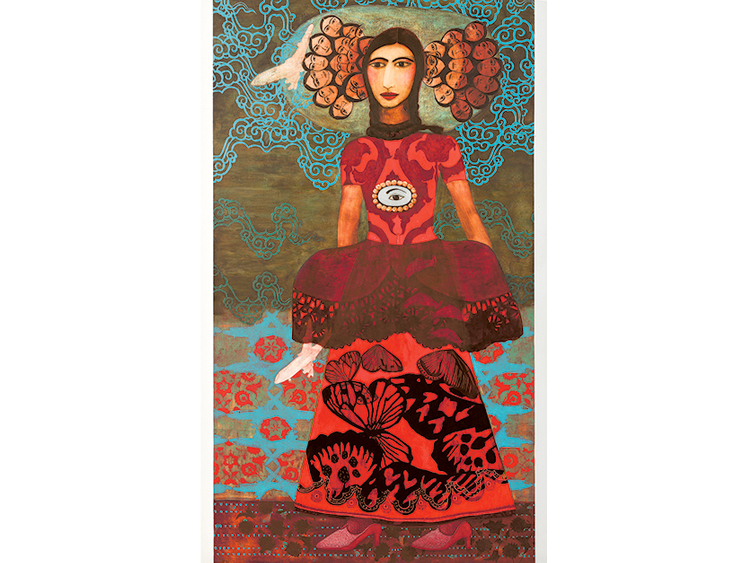
Samira Abbassy was born in Iran, grew up in the United Kingdom and now lives in New York. Not surprising then, that she is interested in exploring ideas of personal and cultural identity.
Her work reflects her Arab-Iranian heritage as well as her understanding of Western art and culture. The artist uses self portraits as a way of examining and defining herself in a constantly shifting cultural context. But the figures in her paintings also represent “the archetypal self”, depicting the psychological, emotional, biological and other intangible aspects of the human experience.
Her first exhibition in the UAE, “An Autobiography & Other Confessions”, features oil paintings on canvas and gesso panel as well as works on paper dating from 2009 to 2014.
“As an immigrant in predominantly white Britain I was forced to ask myself who I am and where I am from. I felt burdened by needing to interpret the culture of my parents without wholly understanding it. I questioned many aspects of my duelling cultures as I tried to integrate, belong and bridge gaps. So I became a “fictional historian”, reinterpreting stories about a homeland that I barely knew.
“I needed a mirror to see myself; and not finding that mirror, I created my own through art. The canvas became for me “a mirror of inclusion”, a place to contextualise myself and establish my identity. Yet, in attempting to explain my relationship to my Arab-Iranian culture, I found I knew little of what this culture really was. This made me uneasy on both sides of the cultural divide,” Abbassy says.
This uneasiness motivated her to research Indian, Persian, Tibetan, Hindu, Islamic, Buddhist and other non-Western art in an attempt to go beyond the language of narrative painting towards the metaphysical.
“Through fusing disparate mythologies and traditions, I came towards an iconography of hybridism and most importantly found their underlying common threads. My discovery of pre-Renaissance art led to a love of religious art of that period, and encouraged me to discover the sacred art of all the major faiths and denominations. I found that all religious imagery provides visual clues for a way into the spiritual state.
“The language of the sacred is better at conveying the metaphorical and describing the metaphysical aspects of being human because here the figure is more easily recognised as an archetype rather than an individual; and the myths and stories presented are timeless, universal, psychic events rather than “real” narratives. The figures in my work are not me, but “the archetypal self” examined as a phenomenon, which combines autobiographical, cultural, psychic and chemical aspects in which events and narratives become incorporated into the body or fragment it,” she says.
Abbassy appears in her paintings in various avatars inspired by Indian goddesses with multiple heads and hands, animal-like figures from Iranian folklore and Western mythological characters. The titles of the works offer clues to their source of inspiration and to the intellectual, cultural, mental and emotional dilemmas that the artist is struggling with.
For example the title “Compulsive Navigation Disorder” is a term she made up to describe a state of mind.
“This piece is about not knowing where you are in the world, and it comments on our present state of being scattered, either as diaspora, or as points on a digital network. The Chinese cloud floating into the composition relates to the influence of Chinese painting on Persian art, conveying the idea of the porous nature of cultural influence and migration, both historically and in contemporary times. The butterflies, birds and aeroplanes on the woman’s skirt juxtapose natural navigation systems with man-made ones. And the brooch on her chest signifies the internal navigation system of the self, recognising the heart as a still point in a tumultuous world,” the artist says.
In “Embalmed”, she has conveyed the idea of fragmentation and preservation of memory and identity through the Egyptian burial ritual of preserving organs in jars. In some paintings, the figures are like X-ray images, revealing the interiors as though presenting a psychic map of the person.
“There are elements of autobiography in my work. But the central figure is an archetype rather than a literal attempt at depicting myself. It is as if I am depicting myself from the inside out, starting with how it feels to be me, or rather how it feels to be human.
“I want to reveal the figure as a psycho-emotional being, and rather than making an objective portrait, I want to depict a “state of being”. My self-portraits are a way of examining “The Self” rather than merely myself,” Abbassy says.
“Middle Eastern and Western culture is inextricably intertwined in my work, just as it is in my personal identity. I believe that there are universal themes that are equally valid in any society; and by appropriating material freely from various cultural traditions, I have tried to create enduring and universal imagery that speaks about human nature and our psyche, and what it is to be human beyond cultural differences,” she adds.
The show will run at XVA gallery, Al Fahidi Historical Neighbourhood until April 1.
Abbassy’s work is also being exhibited at The Metropolitan Museum of Art, New York, in an exhibition titled “Bazm O Razm” (Feast and Fight), which runs until May 31. The show, curated by Maryam Ekhtiar, features Abbassy’s “The Eternal War Series: Second Circle”, acquired by the museum in 2013. The work, comprising modular panels, charts the history of warfare from the era of the sword to modern times, presenting narratives on war and violence through the ages.
Jyoti Kalsi is an arts enthusiast based in Dubai.














